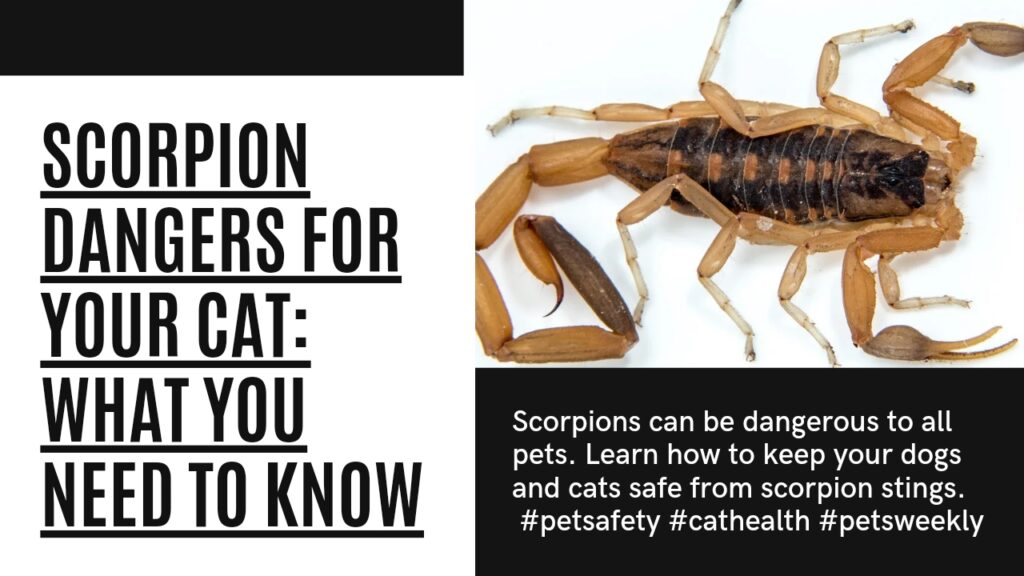Desert Dangers for Pets: The Bark Scorpion
Share

Today we continue our exploration into our Desert Dangers series with a look at the sting of the Bark Scorpion. We’re focusing on the Sonoran Desert, because it’s one of the most beautiful (yet deadly) places in North America for pets. Our goal in covering the different species and their threats to pets is not to frighten you. Of course, a little fear is a healthy thing if you’re just moving to Arizona. But, we would prefer to make you aware of these animals so that you (and your pets) can learn to learn to avoid them! Here is everything you need to know about desert dangers for pets: the bark scorpion edition!
What is the Bark Scorpion?
The bark scorpion, a small but mighty arachnid, packs a venomous punch despite its size. Measuring approximately 2.5 inches long with a light brown, almost bark-like appearance, these nocturnal hunters skitter through the Sonoran Desert in the southwestern United States and northwestern Mexico. While their sting isn’t usually fatal, it can be incredibly painful, causing intense localized pain, numbness, and even muscle spasms.
Despite their fierce reputation, bark scorpions are crucial predators in their ecosystem, primarily feasting on insects like crickets, roaches, and spiders. They use their pincers to grab their prey before delivering a swift sting with their venomous tail.
Arizona is home to (at best count) approximately 56 species of scorpions. Out of all those different species, there is only one scorpion that can really create a problem for your pets if they’re stung – and that’s the bark scorpion…
How Bark Scorpions Impact Our Dogs and Cats
When we talk about desert dangers for pets, we would be remiss not to mention Denise Holzman from the Arizona Poison and Drug Information Center. Holzman conducted a small sample study on the dangers of scorpions to pets. They were able to locate 65 dog owners and 7 cat owners that had experienced a scorpion sting and their owners shared their experiences.
The Bark Scorpion’s Impact on Dogs
Surprisingly, dogs of all sizes fared pretty well. Like humans, larger dogs tolerated the sting better and recovered faster than smaller dogs. The most common symptoms in dogs include:
- yelping
- jumping back
- limping
- head shaking
- head rubbing
- pawing at nose
- licking the sting site
More serious symptoms (which includes tremors, respiratory distress, restlessness) were seen in 39% of the small dogs and 13% of the large dogs. 71% of the dogs were “much better” within four hours, but smaller dogs symptoms averaged about 8 hours.
However, most of the dogs made a full recovery without any further problem. There were a few cases that experienced a more severe reaction, including signs of neurological, cardiovascular and pulmonary collapse.
 The Bark Scorpion’s Impact on Cats
The Bark Scorpion’s Impact on Cats
There is a myth that cats are immune to scorpion stings – this myth is absolutely not true.
Cats in this study experienced a much stronger reaction to the sting of the bark scorpion. All of the cats in the study experienced similar symptoms to the dogs; yelping, pawing, head-shaking, limping, rubbing or licking the sting site, etc.
However, 71% of the cats in the study developed serious symptoms that included:
- tremors
- roving eye movement
- respiratory distress
- agitation
Since there were only seven cats in the study, it’s difficult to know how all cats might react or how frequently cats are stung. One thing is clear, the smaller the animal, the more intense the reaction.
Why cats may be stung less often:
1. Scorpions don’t want to sting – they want to escape. Scorpions only have so much venom available before they can’t hunt or defend themselves. Venom production takes energy, so bark scorpions may choose to conserve it if they perceive the threat as minor or not worth the effort. Like rattlesnakes, they may not release venom at all and instead offer a “dry” sting, which is really more of a warning. A gentle touch or brush against a dog or a human might trigger a dry sting. But, since cats like to play with their prey, the scorpions may need to release a venomous sting.
2. Scorpions will release a “warning” venom which is designed to be painful, but not deadly. When hunting insects, bark scorpions usually go for a full venom injection to subdue their prey quickly. But for larger animals like lizards or even small mammals, they might opt for a dry sting first, assessing the danger before committing to a potentially venomous fight. After experiencing this “warning”, cats may release the scorpion or refuse to play with it, giving the scorpion time to crawl away. But not always.
3. Cats are faster than scorpions and may be able to kill a scorpion before it can sting. Scorpions are quite fast, but as we know, so are cats. This may be one reason why cats have been deemed to be excellent “scorpion hunters”.
4. It may have been a younger scorpion. Younger bark scorpions are still developing their venom glands and may not always deliver a full dose. Additionally, smaller scorpions have less venom to spare, so their stings might be more likely to be dry.
5. Cats are much better at hiding pain than nearly any other animal. They will often not show symptoms until it is too late. This is why it’s important to watch your cats carefully if you’re moving to the desert. If you suspect your cat has been stung, seek immediate veterinary attention. Time is critical, and prompt medical intervention can make a significant difference in their recovery
Regardless of whether you suspect a dry or venomous sting, it’s always best to err on the side of caution and seek medical advice, especially for vulnerable individuals like children or pets. The doctor can assess the severity of the sting and provide appropriate treatment if necessary.

Treating a Scorpion Sting in a Dog or Cat
We always recommend immediate veterinary care for pets (especially cats) if you suspect they have been stung by a scorpion. Symptoms generally manifest within a few minutes of being stung.
If veterinary care is not possible, follow these steps:
- Call Arizona Poison and Drug Information Center (keep their number on hand while in Arizona: 1-800-222-1222 and it’s answered 24 hours a day).
- Combine baking soda and water to form a thick paste and apply to the sting site.
- Restrict your pet’s movements and attempt to keep them calm.
- If they want to lick or scratch, use a cone to keep them away from the site.
- Monitor symptoms for at least eight hours. If they develop respiratory distress, seizure, or other serious symptom, take them to your emergency veterinarian immediately.

If your pet develops any symptoms beyond pain at the site, you should contact your veterinarian. Try to get a good photo of the scorpion you suspect of having stung your pet.
Getting Rid of Scorpions
There are no guaranteed ways of eliminating scorpions from your home. There is no way to avoid them. We once lived in a home where the neighbors began using pest control and the scorpions came to our house. Construction can drive them from one area into another. Please don’t think you can avoid them in the desert. So, how do we get rid of the desert danger for pets that comes in the form of a bark scorpion? Here are a few of our choices in order of preference.
Diatomaceous Earth
In my active pet home, my first choice in avoiding scorpions and stings is to use Food-Grade Diatomaceous Earth (DE). While DE can kill scorpions, it’s not a guaranteed one-shot solution and has some important considerations:
Diotomaceous Earth works by dehydrating insects with its microscopic, abrasive shards. Scorpions, with their exoskeletons, are susceptible to this effect. However, it’s a slow process that can take hours or even days to kill them. For me, the wait is well worth it. DE is not toxic to pets, birds, critters or any other animal that does NOT have an exoskeleton, making it the safest form of pest control.
However, DE needs direct contact with the scorpion (or any insect) to work. Simply applying it around your home won’t guarantee that every scorpion encounters it. You’d need to target potential entry points and hiding spots.
You also need to exercise caution when applying. DE is harmful if inhaled by humans and pets and the white, powdery dust is easy to inhale. Put your pets into a safe area, and use caution when applying it. I always recommend wearing a mask to avoid breathing in the dust.
DE is not as effective in damp areas, as the moisture clumps the DE and reduces its effectiveness. Keep that in mind if you suddenly get rain after applying. You may need to reapply pretty frequently.
Pest Control
According to Wikipedia, “During US nuclear testing, scorpions, along with cockroaches and lizards, were found near ground zero with no recorded adverse effects.” So don’t expect you’ll be rid of these pesky creatures without a fight…
This should set your expectations on whether the scorpions or the pest control is safer for you and your pets. They have to use powerful chemicals to treat homes for scorpions.
If you decide to use a commercial pest control service anyway, make sure you use a group who specializes in scorpion removal. It’s a very different process and much more dangerous chemical. It is VERY IMPORTANT to let them know about your pets. Do your research before hiring any professionals.
If you have fish, reptiles or birds, you really need to think about what you’re putting into the home…
Black Lights
Many Arizona residents make scorpion hunting a family affair. It’s often done on full moons when scorpions are most active, and it involves walking around the house with a black light, seeking out the little guys in crevices of walls and around floorboards. This can be pretty traumatic if you’re like me and hate killing anything. Personally, I suggest you let the professionals handle it. But here’s a video on how it’s done if you’re interested.
Handy Tips
The best option is to avoid being stung in the first place. If you live in area with scorpions, do your best to remove them from the home. But, get in the habit of:
- Checking shoes before putting them on.
- Never reach under rocks or into crevices without gloves
- Don’t lift lids by placing fingers under lip
Common sense goes a long way in the desert. Just pay attention to your surroundings and you’ll learn that the desert is not nearly as hostile as you may think. Respect the land, respect the wildlife, and enjoy having fun in the sun with your pets.










